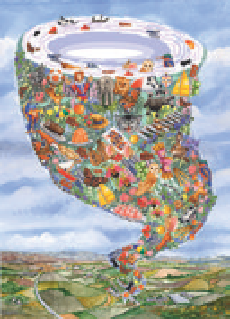Information Technology Reference
In-Depth Information
eventually everyone on the planet connects up. The HTTP protocols that define
HTML Web browsing are extremely simple and have allowed servers to handle
incredible traffic reasonably well. All of the predictions about hypertext -
made decades ago by pioneers like Ted Nelson - are coming true on the Web.
Amazingly it is easier to find information on the Web than it is to find
information on the Microsoft Corporate Network. This inversion where
a public network solves a problem better than a private network is quite
stunning.
I think that virtually every PC will be used to connect to the Internet and
that the Internet will help keep PC purchasing very healthy for many years to
come.
17
Fig. 11.17. The “Browser Wars” were a
rivalry between Netscape Navigator and
Microsoft's Internet Explorer. As a joke,
in the early hours of the morning, the
Microsoft team celebrated the launch of
IE 4.0 in 1997 by placing a giant e on the
lawn in front of Netscape's buildings in
Mountain View, California.
As a result of Gates's memo, Microsoft dramatically changed course. In August
1995, at the same time as the company launched the Microsoft Network
(MSN), a collection of Internet sites and online services, it also included a web
browser called
Internet Explorer
in its release of
Windows 95
. It soon became
clear that the vast majority of users preferred connecting to the free Internet
rather than subscribing to a commercial consumer network like MSN or
America Online (AOL).
Microsoft's first browser, based on licensing the original NCSA Mosaic
code, was fairly primitive. Over the next two years, Internet Explorer and
Netscape Navigator battled for supremacy in the browser market, with each
company releasing several browser upgrades each year (
Fig. 11.17
). By January
1998, Internet Explorer was not only the technical equal of Netscape Navigator
but was also considerably more stable, with many fewer bugs. Because Internet
Explorer was bundled free with the Windows operating system, it rapidly
became the browser of choice for PC users. Netscape's share price fell from its
peak of $175 per share to under $15.
Before AOL acquired Netscape in 1999, Netscape released the source code
for the browser and set up the Mozilla Foundation to manage its future devel-
opment. The foundation describes itself as “a non-profit organization that
promotes openness, innovation and participation on the Internet.”
18
In 2004
Mozilla released the Firefox browser and, by 2007, it had gained a significant
market share, despite the dominance of Internet Explorer and new entrants
to the browser world, such as Safari from Apple and Chrome from Google.
Internet search and the PageRank algorithm
By the mid-1990s, the number and types of websites on the World Wide
Web had grown enormously. In the early days of the web, users had to find
out about “good” websites by word of mouth. Now, finding specific informa-
tion on the web was like looking for a needle in a haystack - a user needed to
search through an unorganized jumble of millions of web pages (
Fig. 11.18
).
In 1994 two Stanford graduate students, Jerry Yang and David Filo (
B.11.9
),
created a website called “Jerry's Guide to the World Wide Web,” which was an
alphabetical directory of interesting websites. Later that year, they renamed
the website Yahoo! and set up a company that grew rapidly during the dot-
com boom. In an attempt to keep up with the rapid growth of the web, Yahoo!
employed teams of editors to help select the websites for the directory.
Fig. 11.18. An artist's impression of the
millions of web pages.


Search WWH ::

Custom Search